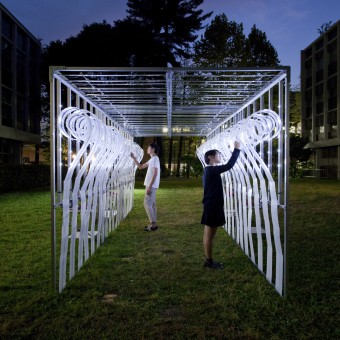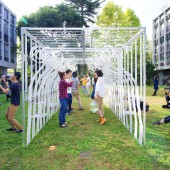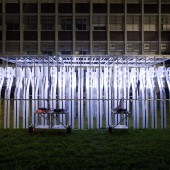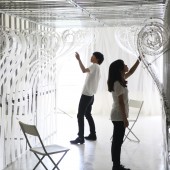Scroll Hut Pavilion by Hiroyuki Futai + EP3 |
Home > Winners > #44291 |
 |
|
||||
| DESIGN DETAILS | |||||
| DESIGN NAME: Scroll Hut PRIMARY FUNCTION: Pavilion INSPIRATION: The design approach is biomimicry, emulating nature's time-tested patterns and strategies. This project focussed on the manner in which a fern frond emerges. So, how is the manner applied to architectural space? The answer is this pavilion with the transformation system between bracket lights and a roof. UNIQUE PROPERTIES / PROJECT DESCRIPTION: Responding to the light, the pavilion shows unique morphing between different geometries. One is the fern, biological swirl form, and the other is the roof, architectural triangular form. These traditional design motifs seamlessly merge into a livable architecture by using today's electronic technologies. OPERATION / FLOW / INTERACTION: During the school semester, the pavilion usually stands on the open floor between classrooms, and students take breaks inside of its space. After each semester, it temporally is moved out and set on the grass between school buildings, and students enjoy playing around its space. PROJECT DURATION AND LOCATION: The project started in April 2011 and finished in Octorber 2014 in Tokyo. FITS BEST INTO CATEGORY: Interior Space and Exhibition Design |
PRODUCTION / REALIZATION TECHNOLOGY: The body is assembled from 40 sets of scroll system with sensors and actuators. During the day, the scrolls roll out and become the translucent roof shade of the pavilion. The photo sensor of each system is monitoring the daylight shifts of its surroundings, and the scroll is rolling out and back individually by a stepping mortar. At night, the scrolls roll back to the ends and work for bracket lights of the pavilion. SPECIFICATIONS / TECHNICAL PROPERTIES: The dimension of the pavilion is as follows: Height 2300mm x Width 2310mm x Lengh 5630mm TAGS: Biomimicry, Pavilion, RESEARCH ABSTRACT: The goal of this project is the integration of digital technology and architectural space. How dose architecture dynamically respond to our actual environment? How is the interaction possible physically and effectively? This project is a small but ambitious experiment toward the goal. It is actually built, and physically interacts with its surroundings. The manner is not partial nor superficial, but is holistic and spatial. The approach to the goal is decentralization. The pavilion is assembled from 40 sets of scroll unit. Each unit has its own transformation system including three sensors, one stepping motor, five led lamps and one control board. Every scroll moves independently responding to the surroundings. So, the pavilion keeps working as a whole against partial malfunctions. In addition, spring steel strips, the non-electric driven mechanism assist the rolling back process of scrolls. CHALLENGE: This project was on the limited budget of $3,000. Its transformation system was improved again and again, and was re-designed as simple as possible in the prototyping phase. Then, in the fabrication phase of 20ft container size, most main parts including scrolls and frames were crafted from common materials. Most electronic parts were soldered by hands of students. Only specific parts including pulleys and rails were fabricated with a 3d printer and a laser cutter for customization. Finally, all these parts were assembled also by hands of students. ADDED DATE: 2016-01-09 06:48:10 TEAM MEMBERS (4) : Art Direction : Hiroyuki Futai, Structural Design : WeiLi Low, Programing : Masato Takeuchi and Production: EP3 IMAGE CREDITS: Image #1: Yuji Nakajima Image #2: Yuji Nakajima Image #3: Yuji Nakajima Image #4: Yuji Nakajima Video Credits:Kazuyuki Miyamoto PATENTS/COPYRIGHTS: Copyrights belong to Hiroyuki Futai, 2014. |
||||
| Visit the following page to learn more: http://www.ep3.cc | |||||
| AWARD DETAILS | |
 |
Scroll Hut Pavilion by Hiroyuki Futai + Ep3 is Winner in Interior Space and Exhibition Design Category, 2015 - 2016.· Read the interview with designer Hiroyuki Futai + EP3 for design Scroll Hut here.· Press Members: Login or Register to request an exclusive interview with Hiroyuki Futai + EP3. · Click here to register inorder to view the profile and other works by Hiroyuki Futai + EP3. |
| SOCIAL |
| + Add to Likes / Favorites | Send to My Email | Comment | Testimonials | View Press-Release | Press Kit |
Did you like Hiroyuki Futai + Ep3's Interior Design?
You will most likely enjoy other award winning interior design as well.
Click here to view more Award Winning Interior Design.








